
table of contents
- spruce cones
- pinecone
- pinecone
- cones of other trees
- frequently asked Questions
Pine cones and their species can be identified based on a few characteristics. The 24 most popular strains to collect are briefly introduced below.
In a nutshell
- "Fir cones" colloquial term for all cones of conifers
- can come from spruce, pine, fir and other trees
- Identify species based on colour, shape and size
- ideally collect in dry weather
- are used for propagation by the contained seeds
spruce cones
Blue spruce (Picea pungens 'Glauca')
Due to the low location requirements and the high insensitivity to air pollution, the blue holly spruce is increasingly being grown in large cities.

- Colour: light brown tint
- Appearance: elongated and curved, thin and wavy covering scales with fine teeth
- Size: 6 to 12 centimeters high
- Tenon orientation: hanging
mean Spruce (Picea abies)
The red spruce is the only spruce species that occurs naturally in Central Europe. All other species of the genus only gradually became native here.
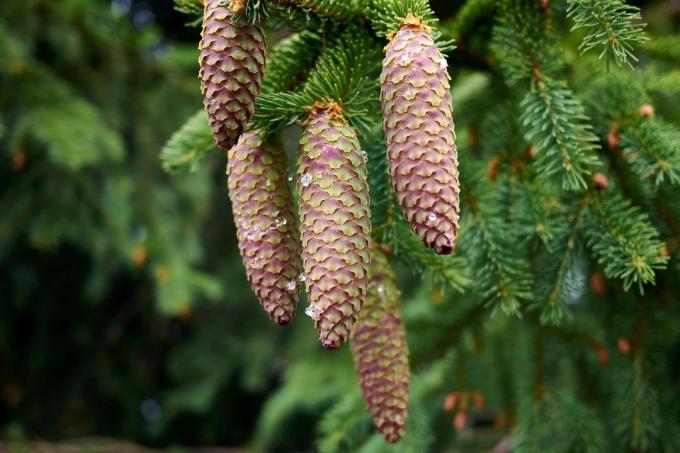
- Color: brown
- Appearance: slender, heavily scaly
- Size: 10 to 15 centimeters long
- Tenon orientation: hanging
Caucasian spruce (Picea orientalis)
The Caucasus spruce is only suitable as a decorative coniferous tree, as the wood cannot be used for forestry purposes.

- Colour: first green tint, then dark brown
- Appearance: elongate with a point, broad and round covering scales without teeth
- Size: 5 to 9 centimeters high
- Tenon orientation: hanging
Serbian spruce (Picea omorika)
The Serbian spruce is only cultivated in mixed cultures, as it hardly reproduces in its pure form.

- Colour: first violet tint, then light brown
- Appearance: pyramidal with a point, broad and round covering scales with slight serrations
- Size: 3 to 6 centimeters high
- Tenon orientation: hanging
White spruce (Picea glauca)
The white spruce, which is now also native here, originally comes from North America and is also known under the name mold spruce.
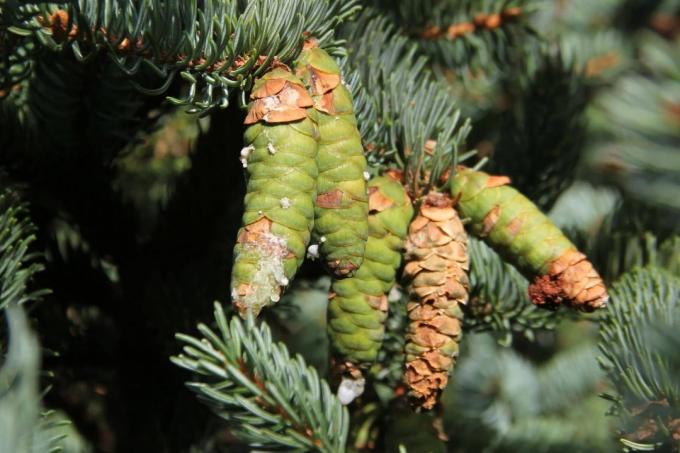
- Colour: orange-brown tint
- Appearance: cylindrical with a point, smooth and round scales without serrations
- Size: 5 to 6 centimeters high
- Orientation of tenons: all directions of growth possible
pinecone
Mountain pine (Pinus mugo)
Due to its thin trunk and branches, the mountain pine is increasingly attacked by mold spores, which is why it should always be well ventilated.
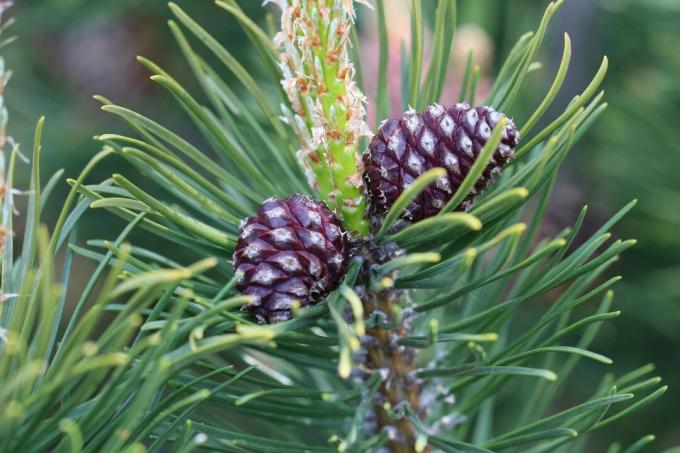
- Colour: light brown tint
- Appearance: rounded with no discernible tip, narrow and pointed covering scales without teeth
- Size: 3 to 7 centimeters high
- Tenon orientation: hanging
ponderosa pine (Pinus ponderosa)
The female flowers of the yellow pine have a striking red-purple colour, while the male flowers shine in a strong shade of red.
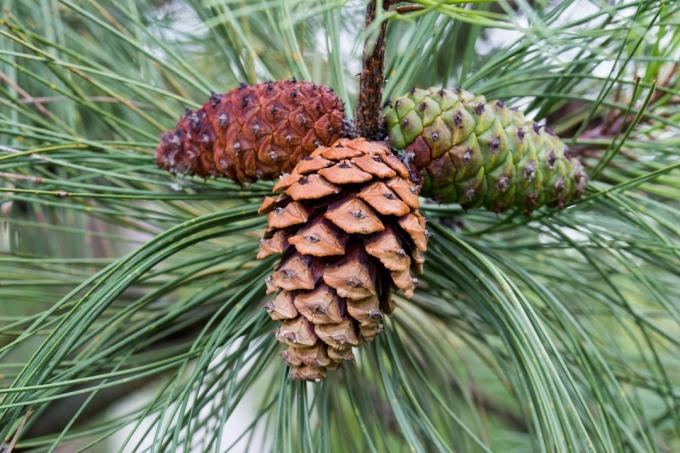
- Colour: reddish brown colour
- Appearance: ovoid with a flat tip, slightly asymmetrically arranged cover scales without teeth
- Size: 5 to 15 centimeters high
- Tenon orientation: hanging
Snakeskin Pine (Pinus leucodermis)
Care should be taken when collecting the snakeskin pinecones due to the thorny surface.

- Colour: first violet tint, then brownish
- Appearance: elongated with a point, broad covering scales with thorns
- Size: 5 to 10 centimeters high
- Tenon orientation: hanging
Temple pine (Pinus bungeana)
The grayish discoloration of the bark with increasing age, the temple pine is very popular.

- Colour: dark brown tint
- Appearance: ovoid with a flat tip, broad covering scales with thorns
- Size: 5 to 7 centimeters high
- Tenon orientation: hanging
notice: The Temple Pine is also often referred to as Bunge's Pine, after its "discoverer".
Scots pine (Pinus sylvestris)
Its importance for the timber and forestry industry makes the Scots pine one of the most commonly cultivated native tree species.

- Colour: dark grey-brown
- Appearance: ovate, woody with a short stalk
- Size: 8 centimeters long, about 3 centimeters wide
- Tenon orientation: hanging
Swiss stone pine (Pinus cembra)
The stone pine forms cones at the earliest after 50 years of life.

- Colour: light brown tint
- Appearance: oval shaped with a flat tip, broad covering scales with thorns
- Size: 6 to 8 centimeters high
- Tenon orientation: hanging
pinecone
Andean Fir (Araucaria araucana)
Only the female flowers of the Andean fir form pine cones that can reach the size of a coconut.

- Colour: reddish brown colour
- Appearance: ovoid with a flat tip, close-fitting covering scales without teeth
- Size: 15 to 20 centimeters high
- Tenon orientation: standing horizontally
Balsam fir (Abies balsamea)
The needles and resin of the balsam fir have a pleasant smell, while the cones are odorless.
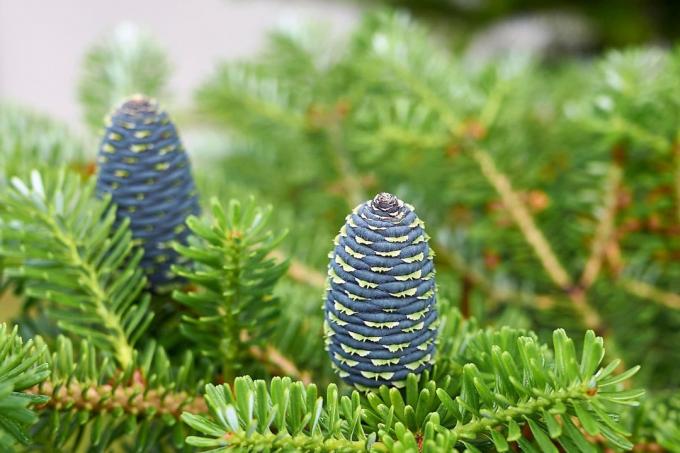
- Colour: grey-brown tint
- Appearance: pyramidal with a narrow tip, superimposed covering scales without teeth
- Size: 5 to 10 centimeters high
- Tenon Orientation: Upright
Noble fir (Abies procera)
The cones of the silver fir are among the largest of their kind and cause branches to hang down in many places.

- Colour: light brown tint
- Appearance: barrel-shaped with no discernible tip, superimposed covering scales without teeth
- Size: 18 to 25 centimeters high
- Tenon Orientation: Upright
Korean fir (Abies koreana)
The female cones of the Korean fir have a high ornamental value and contribute to its increasing popularity.

- Colour: dark blue/dark violet to brown
- Appearance: Coated with resin, with strongly reflexed cover scales
- Size: up to 7 centimeters long
- Tenon Orientation: Upright
Nordmann fir(Abies nordmanniana)
the Nordmann fir only develops its iconic pine cones in the upper third.
- Colour: dark brown tint
- Appearance: oblong with no discernible tip, broadly curved covering scales without teeth
- Size: 12 to 20 centimeters high
- Tenon Orientation: Upright
Notice: The Nordmann fir is one of the most popular types of fir and is increasingly used as a Christmas tree.
umbrella fir (Sciadopitys verticillata)
While the male flowers of the umbrella fir shine in a strong shade of yellow, the female counterparts are dark brown in color.

- Colour: light brown tint
- Appearance: ovate or elongated with a slight tip, broad covering scales without teeth
- Size: 6 to 10 centimeters high
- Tenon Orientation: Upright
Silver Fir (Abies alba)
The ingredients of the white pine cones have an antibacterial effect, so they can be used for inhalation and as a balm.

- Colour: light green tint
- Appearance: barrel-shaped with a flat tip, close-fitting covering scales without teeth
- Size: 10 to 16 centimeters high
- Tenon Orientation: Upright
Notice: The silver fir is the only fir species in Central Europe with a natural distribution. All other fir species only became native here over time.
cones of other trees
Occidental tree of life (Thuja occidentalis)
The oil extracted from the western tree of life is used for the treatment of rheumatism.
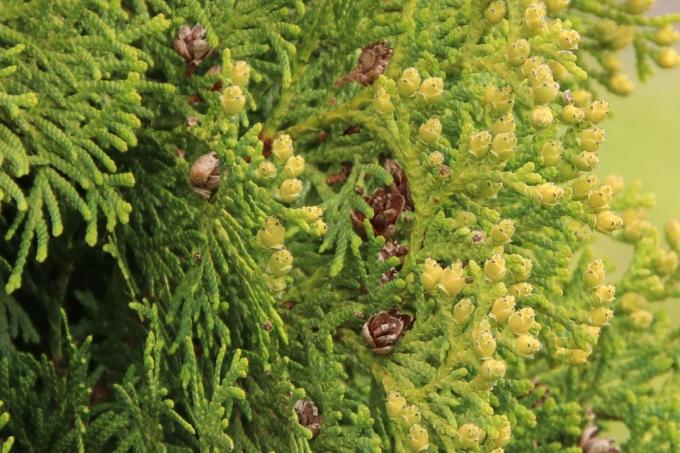
- Colour: light green tint
- Appearance: ovoid with a star-shaped tip, thick and elongated covering scales without teeth
- Size: 1 to 2 centimeters high
- Tenon Orientation: Upright
Notice: The Occidental Tree of Life is better known as "Thuja".
Arizona cypress (Cupressus arizonica)
The Arizona cypress gives off a fragrant scent all year round, which is why the parts of the plant are increasingly being packed in scented sachets.
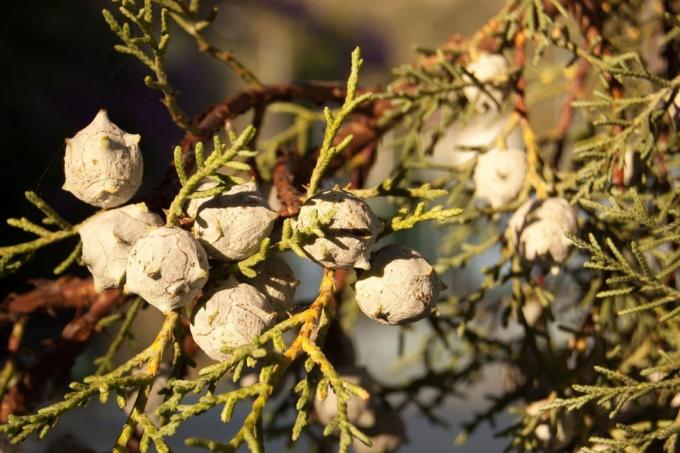
- Colour: first light green, then brown
- Appearance: spherical with no discernible tip, thick and wide covering scales without teeth
- Size: 20 to 25 centimeters high
- Tenon Orientation: Upright
Notice: In dried form, the individual parts of the plant are just as fragrant.
Atlas cedar (cedrus atlantica)
The cones of the Atlas cedar decay after a maximum of three years, but leave behind a woody spindle.

- Colour: first light green colouring, then light brown
- Appearance: barrel-shaped with a dented tip, slight grooves on the covering scales, no teeth
- Size: 5 to 7.5 centimeters high
- Tenon Orientation: Upright
European larch (Larix decidua)
The larch can withstand temperatures down to -36 degrees Celsius and is therefore also suitable for locations with permafrost.
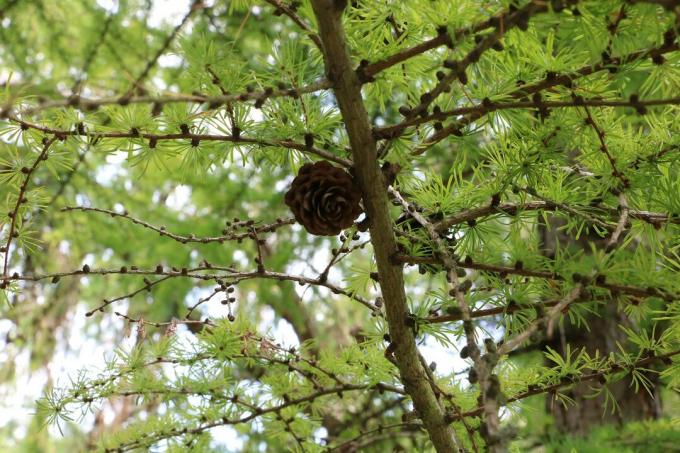
- Colour: light brown tint
- Appearance: ovoid with a flat tip, rounded covering scales with a little hair and without teeth
- Size: 1 to 6 centimeters high
- Tenon Orientation: Upright
Common juniper (Juniperus communis)
The cones of the common juniper only mature in the second year after fertilization.
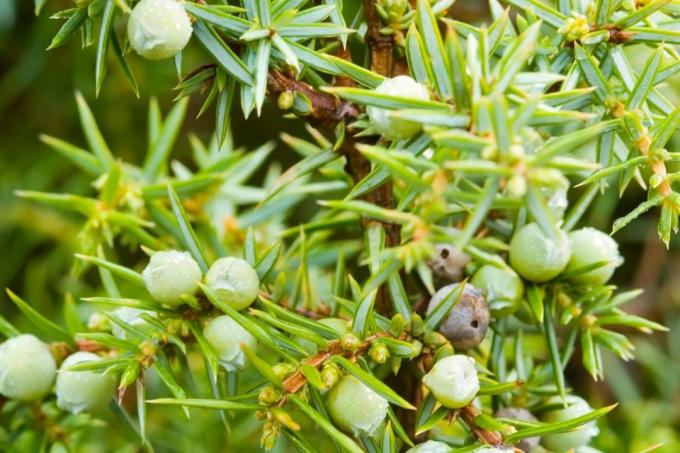
- Colour: first green, then black
- Appearance: spherical with a slight tip, no covering scales
- Size: 0.5 to 1 centimeter high
- Tenon orientation: standing horizontally
Douglas fir (Pseudotsuga menziesii)
Although the Douglas fir is a species of its own, it combines many characteristics of the pine, Fir and spruce species.
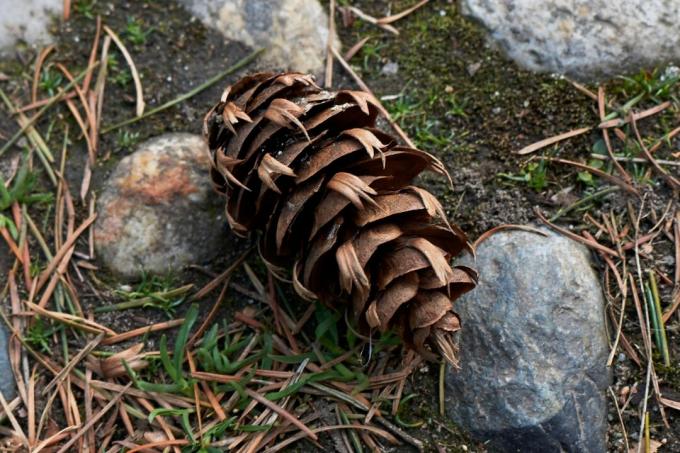
- Colour: brown tint
- Appearance: elongated with a thorny tip, narrow and long covering scales without teeth
- Size: 5 to 10 centimeters high
- Tenon orientation: hanging
frequently asked Questions
The pine cones usually contain between 100 and 150 seeds, which are released when the cones fall off. This makes it possible for the tree to multiply in the immediate vicinity.
In addition to the propagation aspect, the fruits can also be used as decoration in the house. In addition, they are ideal as bird feed and as fuel. Before using it, however, you should identify the local fruit precisely in order to rule out a toxic effect.
In damp weather, the openings between the individual covering scales close. The water contained in the air is absorbed by the scales and causes them to swell. In dry weather, on the other hand, the moisture is released to the environment, which in turn leads to a narrower shape and noticeable opening.



